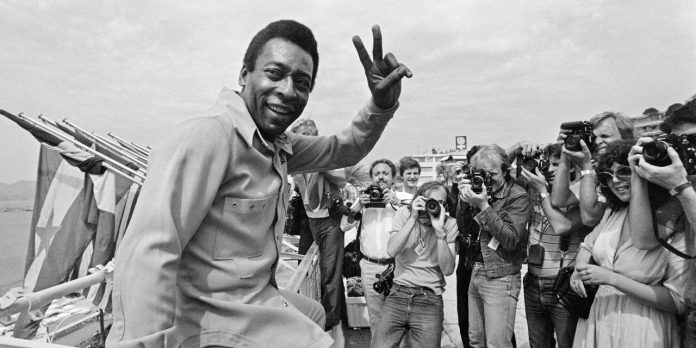Pelé at the Cannes International Film Festival in France, May 14, 1981.
Photo:
ralph gatti/Agence France-Presse/Getty Images
A few years after retiring from soccer, Pelé starred with John Huston in the movie “A Minor Miracle.” Shooting was scheduled for the fall of 1982, in San Diego, and I was the director.
When the crew drove down from Los Angeles, I decided to ride with Pelé’s entourage in his stretch limo to get to know him better before filming began. The group numbered about nine, and I was the only representative of the production. When everyone got hungry en route, I didn’t know where to stop for lunch, and I couldn’t take Pelé just anywhere. He suddenly pointed out the window and shouted in his heavy Brazilian accent: “Chart House!” As it happened, the Chart House chain was one of Pelé’s favorites in America, and there it was, right off the highway.
The moment we entered the restaurant, Pelé was recognized. Within minutes, busboys, waiters and soon diners were strolling by our table to get a closer look at the man Reader’s Digest declared the second-most famous person in the world, slightly behind Pope John Paul II.
This was decades before the internet and cellphones, and remarkable for a man who later told me the story of his childhood in the mountains of Brazil, where his family never had a home without a dirt floor. His family was so poor that when he was 15 and was offered a contract to play for the professional soccer team Santos, his mother sewed two pairs of short pants together to make a mismatched long pair for him to wear to the signing. She didn’t want her son to be embarrassed because pictures would be taken, and the family couldn’t afford a pair of pants to be worn only for a ceremony.
While we were eating, a busboy edged his way to the table and, while refilling the water glasses, shyly asked Pelé if he would mind coming to a pay phone near the kitchen to say hello to the busboy’s mother, who lived in Guadalajara, Mexico , and was waiting on the line.
Pelé, whose native language was Portuguese, spoke passable Spanish but very little English. He immediately brightened and told the busboy he would be happy to. He got up, and with his Cuban bodyguard, Pedro, who followed him everywhere, went to the bank of pay phones.
Pelé lifted the dangling receiver and, constantly interrupted by workers stopping to shake his hand, talked to the young man’s mother for at least 10 minutes, learning the names and ages of her entire family, including pets, before returning to the table. The busboy was thrilled.
After lunch, Pelé asked his assistant to bring promotional photographs from the limo. He spent the next 15 or 20 minutes autographing them for the restaurant staff, until every employee and customer received a signed photo.
Over the course of our filming and beyond, I realized this was standard behavior for Pelé, who proved to be as generous, open and kindhearted as anyone you could hope to meet. John Huston described him to me as being framed by a “black light.” When I asked what he meant by that, Huston looked up with wet eyes and said: “Purity.”
Mr Tannen is a screenwriter and film director.
Journal Editorial Report: The year’s best from Kim Strassel, Kyle Peterson, Mary O’Grady, Dan Henninger and Paul Gigot. Images: Zuma Press/Nasa Composite: Mark Kelly
Copyright ©2022 Dow Jones & Company, Inc. All Rights Reserved. 87990cbe856818d5eddac44c7b1cdeb8
Appeared in the January 3, 2023, print edition.

